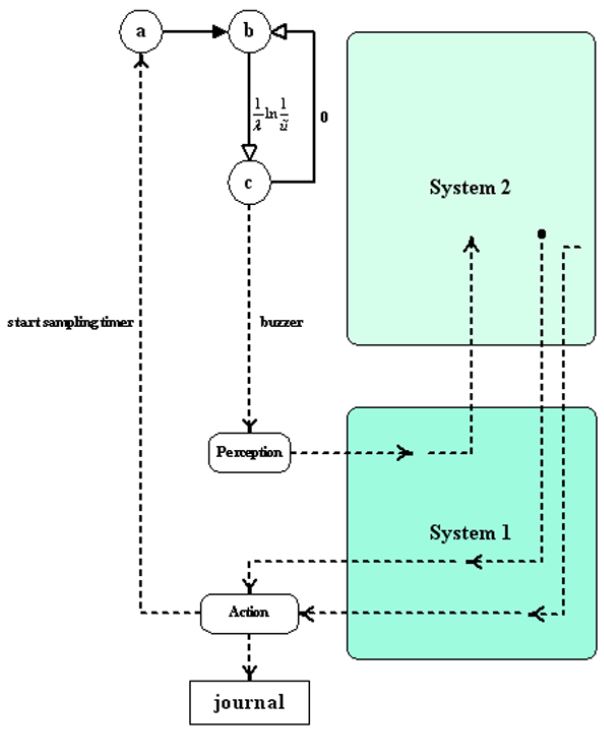Although "Giant Brains" by computer scientist Edmund C. Berkeley captured my pre-adolescent attention in the 1950s, it was in the 1960s that I became self-aware. Urgently fascinated with my conscious thoughts, I rigged a foot-pedal to a tape recorder in an attempt to record audio snapshots of my mind. By the late 1970s early 1980s I planned to build the "Mind Mapper" tiny portable microcomputer, which was supposed to make an audible ping at random times during the day. The idea was to write down a word or brief phrase describing the conscious thought that was interrupted by the ping. The accumulated data would be analyzed for patterns that represent the person's interior life. I was not assuming this was an original idea, and sure enough, an article "Modes of Normal Conscious Flow" (in "The Stream of Consciousness," edited by Kenneth S. Pope and Jerome L. Singer, 1978) by Eric Klinger included the "Minnesota Thought-Sampling Study" confirmed that thought sampling was already in the psychology zeitgeist.
A conscious thought sample occupies a moment of time, so consciousness and time are mutually inextricable. This complex has occupied great minds, from the mystic Georges Gurdjieff who taught one to "remember oneself," to the phenomenologist Edmund Husserl who analyzed subjective "retentions and protentions," to the psychologist William James' unfolding of the "specious present," to the immuno-biologist and neuroscientist Gerald Edelman who wrote a book entitled, "The Remembered Present."

In my book on "Microlects of Mental Models" (2015) there is a "timing machine mental model diagram for the Stochastic Thought-Sampling Experiment," with random times selected by a Poisson process, and relating events in System 1 and System 2 (as in "Thinking Fast and Slow" by Daniel Kahneman). But that was my last thought on the topic, until a few days ago.
I happened to pick up the current issue (Ocotber 1-7, 2016) of "New Scientist" because the cover says "Your Conscious Unconscious, Your life is ruled by thoughts you don't control." Believe me, I was astounded to read in an article by Caroline Williams that "Russell Hurlburt, a psychologist at the University of Nevada, Las Vegas ... asks volunteers to wear an earpiece linked to a beeper, which goes off at random intervals six times a day, prompting them to note their thoughts." This I had to google. I rushed to order his book, "Investigating Pristine Inner Experience: Moments of Truth," for which the advertisement says "The author, a pioneer in using beepers to explore inner experience, draws on his 35 years of studies to provide fascinating and provocative views of everyday inner experience and experience in bulimia, adolescence, the elderly, schizophrenia, Tourette's syndrome, virtuosity, and so on." Not only that, Hurlburt teaches introductory statistics - just like me.
I have not yet opened the package with his book in it. Here is what I think, going in. I imagine the world-wide Attention Network. The nodes are people, and also possible foci of attention. At any given moment of time, a person node is linked to their concious thought focus of attention (if there is a salient one). It is possible that many people at that moment happen to be focused on Hillary Clinton, or on the War in Syria. Someone may be focused on an itch at that moment, known only to themselves. Stochastic Attention Sampling (STATS) uses smartphones (possibly something like Hurlburt's iPromptU, "an iPhone application that presents prompts at random or fixed time intervals and collects the user’s responses"). Statistical network analysis of a large sample of the world-wide Attention Network would be applied to discover whether, for example, their are preferential attachment power laws that unify some of the data.